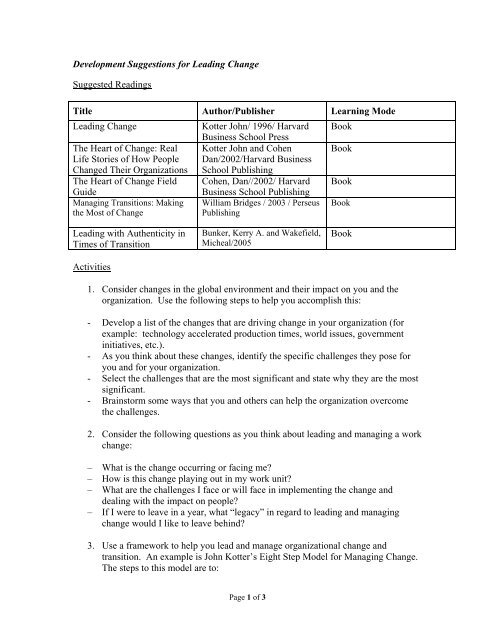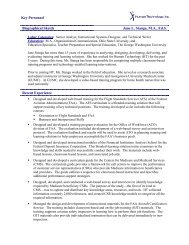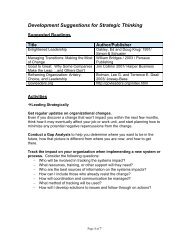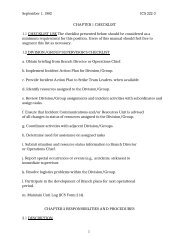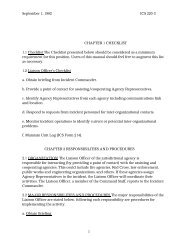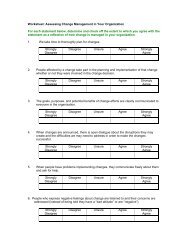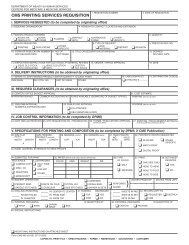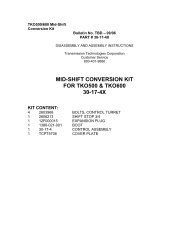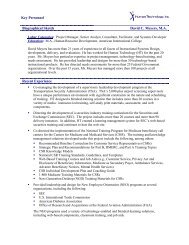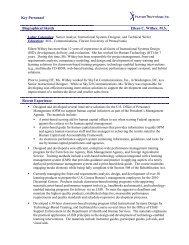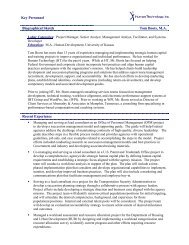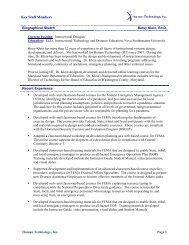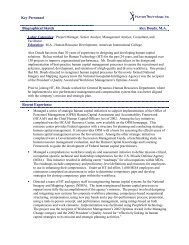Leading Change - Human Technology, Inc.
Leading Change - Human Technology, Inc.
Leading Change - Human Technology, Inc.
Create successful ePaper yourself
Turn your PDF publications into a flip-book with our unique Google optimized e-Paper software.
Development Suggestions for <strong>Leading</strong> <strong>Change</strong><br />
Suggested Readings<br />
Title Author/Publisher Learning Mode<br />
<strong>Leading</strong> <strong>Change</strong><br />
Kotter John/ 1996/ Harvard Book<br />
Business School Press<br />
The Heart of <strong>Change</strong>: Real Kotter John and Cohen Book<br />
Life Stories of How People<br />
<strong>Change</strong>d Their Organizations<br />
Dan/2002/Harvard Business<br />
School Publishing<br />
The Heart of <strong>Change</strong> Field Cohen, Dan//2002/ Harvard Book<br />
Guide<br />
Managing Transitions: Making<br />
the Most of <strong>Change</strong><br />
Business School Publishing<br />
William Bridges / 2003 / Perseus<br />
Publishing<br />
Book<br />
<strong>Leading</strong> with Authenticity in<br />
Times of Transition<br />
Activities<br />
Bunker, Kerry A. and Wakefield,<br />
Micheal/2005<br />
Book<br />
1. Consider changes in the global environment and their impact on you and the<br />
organization. Use the following steps to help you accomplish this:<br />
- Develop a list of the changes that are driving change in your organization (for<br />
example: technology accelerated production times, world issues, government<br />
initiatives, etc.).<br />
- As you think about these changes, identify the specific challenges they pose for<br />
you and for your organization.<br />
- Select the challenges that are the most significant and state why they are the most<br />
significant.<br />
- Brainstorm some ways that you and others can help the organization overcome<br />
the challenges.<br />
2. Consider the following questions as you think about leading and managing a work<br />
change:<br />
– What is the change occurring or facing me?<br />
– How is this change playing out in my work unit?<br />
– What are the challenges I face or will face in implementing the change and<br />
dealing with the impact on people?<br />
– If I were to leave in a year, what “legacy” in regard to leading and managing<br />
change would I like to leave behind?<br />
3. Use a framework to help you lead and manage organizational change and<br />
transition. An example is John Kotter’s Eight Step Model for Managing <strong>Change</strong>.<br />
The steps to this model are to:<br />
Page 1 of 3
-Establish a sense of urgency<br />
-Create a guiding coalition<br />
-Develop a compelling, shared vision<br />
-Communicate the change vision<br />
-Enable others to act on the vision<br />
-Generate short-term wins<br />
-Consolidate gains - don’t let up<br />
-Anchor the new approach in the culture<br />
You can learn more about how to implement these change management steps by reading<br />
the books on the recommended reading list by John Kotter or my taking the class on<br />
<strong>Leading</strong> <strong>Change</strong> offered through the USPTO Leadership Development Program.<br />
4. Align organization/unit structure, functions, policies, and interrelationships to<br />
meet mission requirements.<br />
5. Define work unit vision, mission, and goals to establish priorities, provide<br />
direction, and guide resource allocation decisions.<br />
6. Develop long-term organizational and interoperability strategies and strategic<br />
policies.<br />
7. Develop visions and objectives for the organization/unit that align with strategic<br />
objectives of the USPTO and the broader community.<br />
8. Plan long- and short-term strategies that incorporate mission priorities and<br />
resource availability.<br />
9. Articulate and actively support the USPTO's vision in a way that inspires<br />
employees at all levels to own the organization's goals, values, and strategies.<br />
10. Apply a long-term perspective in examining policy issues and developing<br />
strategic plans.<br />
11. Adjust strategic policies and plans in response to change, both internal and<br />
external (e.g., financial, technical, human resource).<br />
12. Think of a change that you want to implement in the organization. Build and<br />
communicate a powerful and compelling case for the change by communicating<br />
the four “Ps” to employees:<br />
– Purpose – Why we are doing this<br />
– Picture – What the outcome will look like and how people will fit into that<br />
picture<br />
Page 2 of 3
– Plan – Steps the company will take to implement the change and ensure people<br />
receive the needed training and support<br />
– Part – Their role in shaping and guiding the change.<br />
13. Develop a list of the actions you can take to better lead and manage change in your<br />
organization.<br />
14. Identify the informal ways that you can include people in the change and transition<br />
process.<br />
15. Use a tool such as the Force-Field Analysis to help you explore the consequences of a<br />
change by charting the positive and negative forces that enhance or hinder the<br />
implementation of that change.<br />
Page 3 of 3


